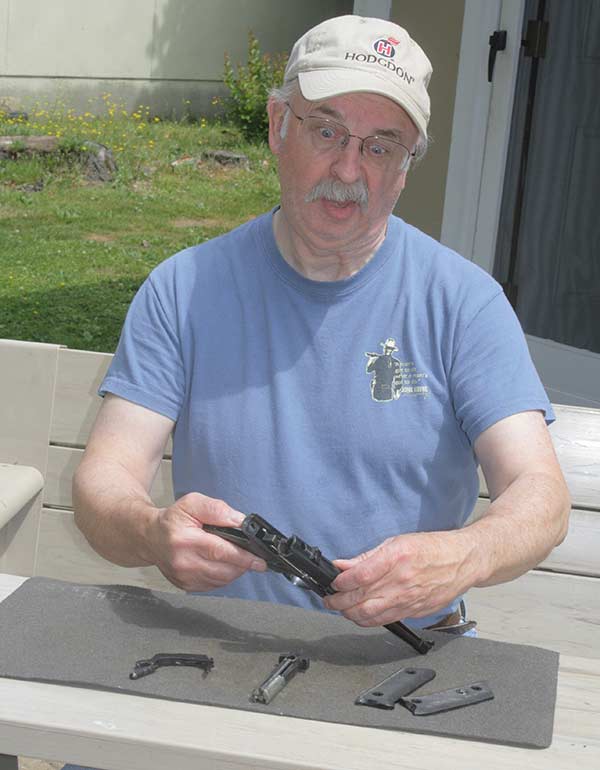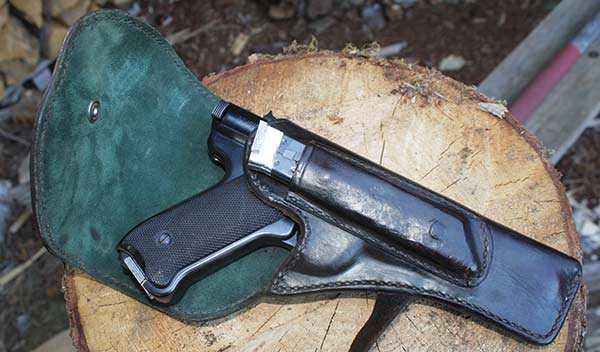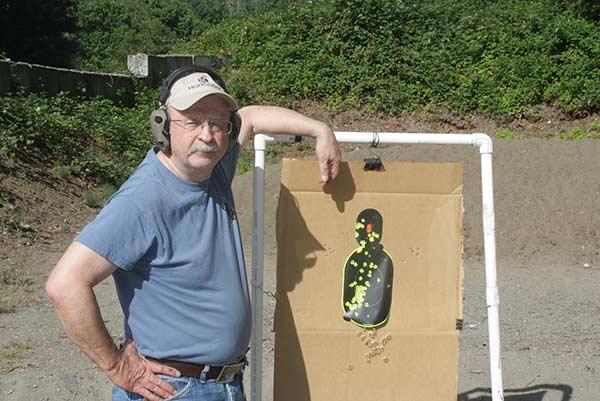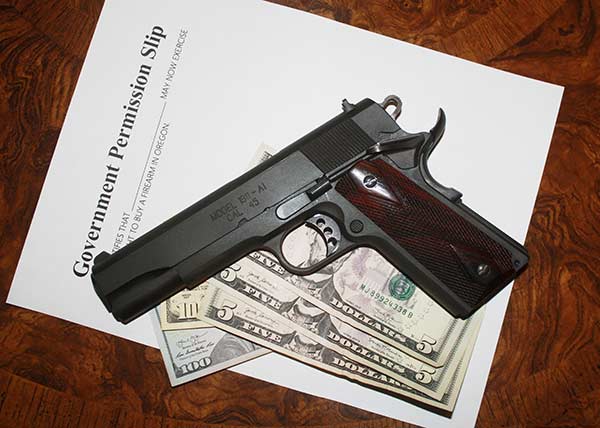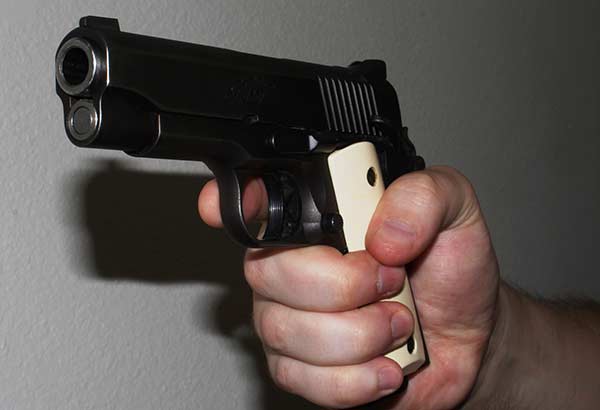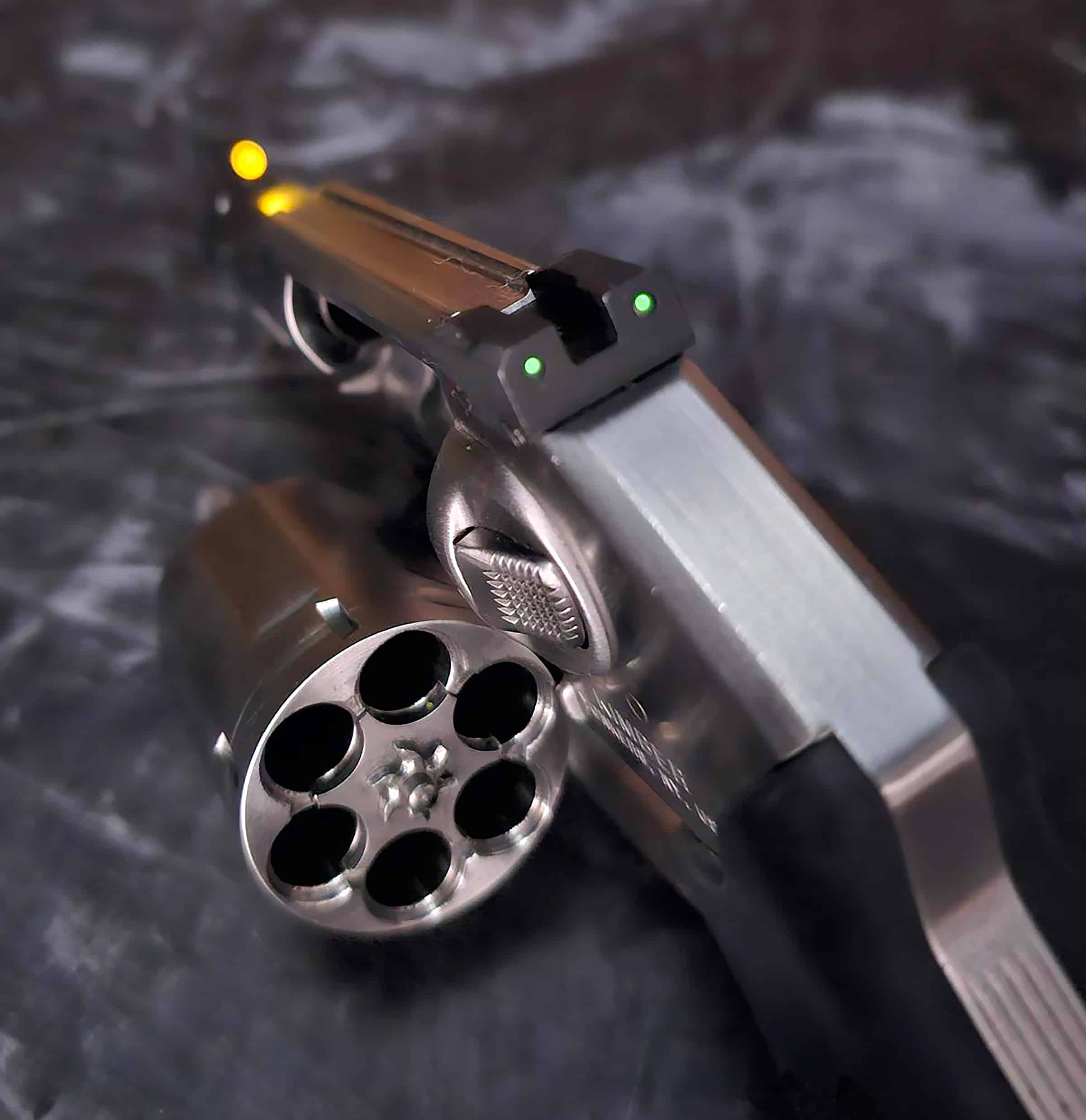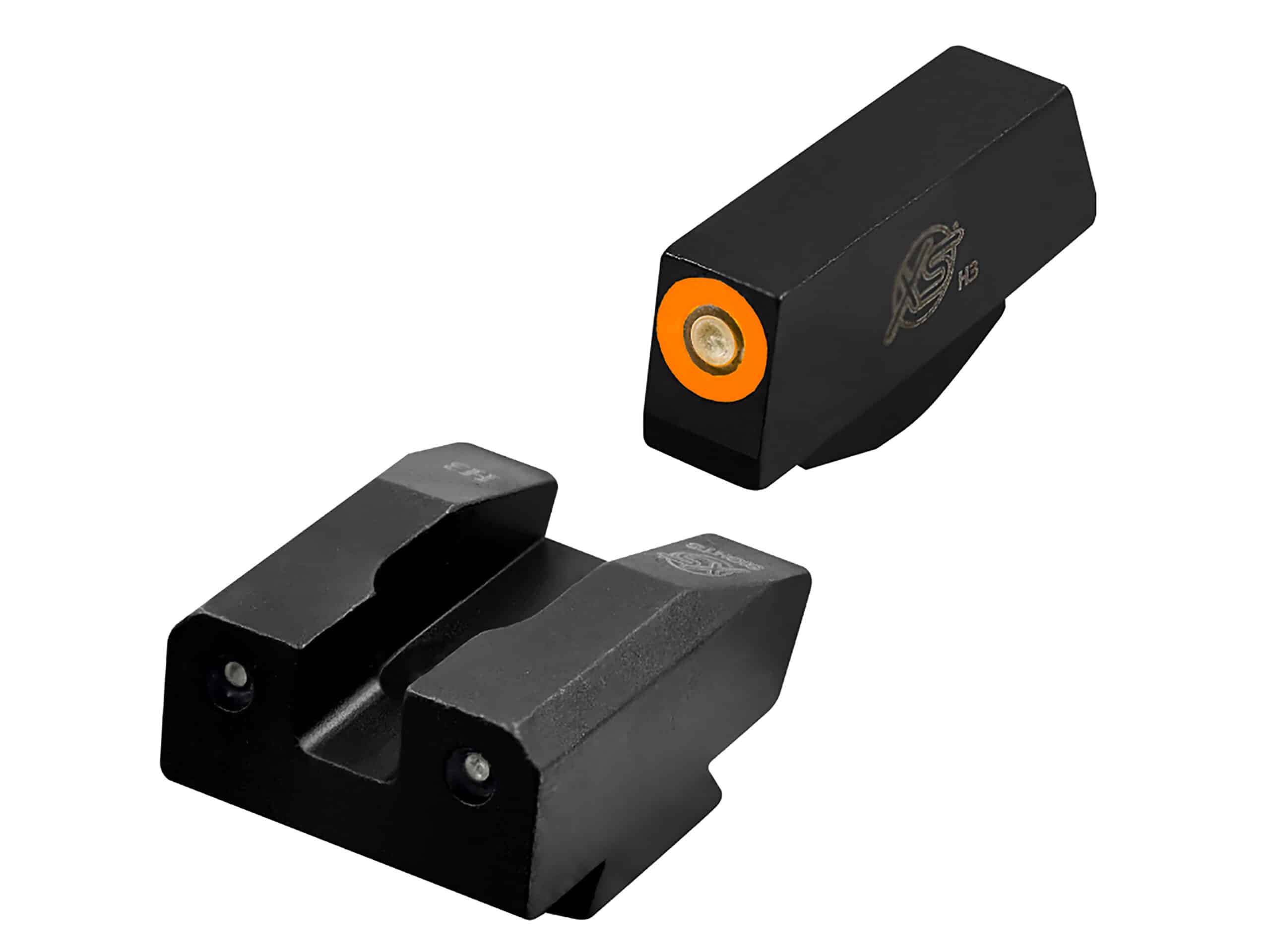
Category: Gear & Stuff
Ever have one of those days when an idea — that started off bad — went steadily downhill from there?
This began on a Sunday morning in mid-July when — for reasons I still can’t explain — it seemed like a grand notion to start prepping for my early season small game hunting, which kicks off Sept. 1 for cottontails and catches fire Sept. 15 when the grouse season opens here in Washington. The catch: I’m going to use a rimfire pistol on the opener.
How I talk myself into these fixes is a mystery. However, in for a penny, in for a pound, which is typically a really dumb standard for long-term contentment.
Out of storage comes my trusty old, original Ruger Standard (precursor of the MK I), and I should have stopped right there. To make sure everything would be ready to rock, I decided to strip this classic handgun down for a full cleaning. Somewhere in the back of my mind, I faintly heard comedian Jay Leno asking, “How stupid is that?”
My longtime, and sadly gone, amigo Dick Burnett once observed, “The Ruger .22 pistol is a gun you can take apart in about a minute, and then you spend the next hour trying to put it back together again.” Uh, huh.
Dismantling the Ruger Standard — and subsequent MK I, II and III versions — is not that difficult, usually. Pull the locking arm in the middle of the mainspring outward, using a paper clip because it can be tight. Then pull the mainspring assembly out, and down, withdrawing the big bolt plug which goes up through the rear of the upper receiver, holding the bolt in place. It may take some tapping with a nylon rod. In my case, several taps didn’t do it. I had a feeling the pistol was trying to tell me something, but I don’t hear so good these days …
I don’t know why, but this time the bolt block initially wouldn’t budge. After applying a few drops of penetrating oil, it came out lickety-slick! Go figure.
I did some cleaning, inside and out; the bolt, firing pin, the interior of the receiver and chamber and then applied a couple of drops of really good gun oil. Putting this pistol back together requires patience (there’s an annoying video on YouTube of a guy getting it all back together in 16 seconds; I hate videos like this) and a good feel for things.
There’s a small arm that comes down from the hammer, and you’ve got to catch it just right on the mainspring as the pistol is reassembled, or the gun just won’t work. If you feel a little pressure as the you seat the mainspring, you’ve done it right. If not, you’ve joined a huge fraternity of Ruger pistol owners who now know better.
Somewhere, I heard gun shops often have older Ruger MK I, II and III pistols for sale because the owners just couldn’t stand reassembling the buggers. Not sure I believe that (I’ve never seen it), because they’re very accurate pistols, and with the advent of today’s aerosols, disassembly isn’t really necessary. But, if you do take one apart, set aside twice as much time as you think will be necessary, unless you’re one of these show-offs on video.
Have a Good Light
It’s good to do this where there is plenty of light because you’ll be looking repeatedly into the mainspring slot to make sure the little arm from the hammer is hanging down where the mainspring can catch it.
My now-retired family doctor had one of these pistols, and so far as I know, he never got it back together after disassembly about eight or nine years ago. He told me about it. I sent him a how-to video, and even offered to come over and help him put everything back where it belonged. It’s probably still in parts in a box because he got interested in racing cars after retirement, and they go back together a lot easier, I’ve determined.
Moving right along, after getting my pistol back together, I grabbed a box of cartridges and headed to the range. All four of my magazines were already loaded with a full nine rounds apiece, so I had just over 85 rounds to fiddle with.
I’ve written here before about how I snagged this pistol at a gun show many years ago, taking it to the range that evening and literally hitting everything I aimed at. Kudos to Ruger for building a pistol that, in my case at least, was dead-bang accurate. Couple of months later, I was conking grouse with it. That was then …
Low and Left
This time, well, I evidently need more range work. My first two attempts to fire were scary, because both cartridges misfired. They simply didn’t go “BANG!” It was unnerving because it’s never happened before like that, and I started worrying that I had broken something. The third, and every subsequent round, did go off, so contentment was partly restored as everything worked.
However, the pistol was now shooting slightly low and to the left as shown in the accompanying image. Lucky for me I’ve got a healthy stockpile of .22 LR ammunition, so as you read this, I’m probably down at the range. Or having my eyes checked.
My pistol has fixed sights, though the rear is drift-adjustable, being dovetailed into the top rear of the receiver. Past experience told me the pistol is capable of point-of-aim accuracy, so I’m convinced the problem is me, not my classic Ruger.
There are a couple of takeaways in this tale. First, be prepared to spend some time at the range if you get inspired to hunt small game with a rimfire pistol. Second, give serious consideration to not stripping down your semi-auto. Third, just because I’m planning to do it doesn’t mean you need to follow my example. You’ve been warned!
Oregon Battleground
Last month, anti-gunners were chortling in Oregon when U.S. District Judge Karin Immergut handed down a 122-page decision in a federal challenge of Oregon’s hotly contested gun control Measure 114, which makes the Beaver State a rotten place for gun owners.
Immergut consolidated four federal lawsuits, and her ruling displayed some strained logic. At one point, the judge observed, “The Supreme Court has held that Second Amendment protects an individual right to self-defense inside and outside of the home. LCMs are not commonly used for self-defense and are therefore not protected by the Second Amendment.”
Better consult millions of law-abiding armed citizens, especially those who have defended themselves with handguns fitted with LCMs (large capacity magazines), and a million street cops now armed with GLOCK, SIG Sauer, Smith & Wesson and other duty sidearms, also equipped with magazines holding more than ten cartridges.
Judge Immergut — a Donald Trump appointee — also declared, “Plaintiffs have not shown that the Second Amendment protects large-capacity magazines, defined as magazines capable of firing eleven or more rounds without reloading. And even if the Second Amendment were to protect large-capacity magazines, this Court finds that Defendants and Intervenor-Defendant have established that Oregon’s restrictions on the use and possession of large-capacity magazines are consistent with the Nation’s history and tradition of firearm regulation.”
The measure also requires proof of safety training in order to obtain a permit-to-purchase from law enforcement and undergo a background check including a mental health check. Together, this sounds like Oregon considers the right to keep and bear arms as a government-regulated privilege.
Appeals from the Second Amendment Foundation, National Shooting Sports Foundation and other participants in the four federal lawsuits are in the works.
Meanwhile, a trial is scheduled next month in the state level challenge which has continued to block implementation of Measure 114. The trial will be held in Harney County Circuit Court in eastern Oregon.
Oh, the Irony
A report on Fox News last month got my attention for reasons that will become obvious momentarily.
After the Supreme Court handed down its Bruen ruling last year, lawmakers in New York scrambled to make their concealed carry law worse than the one which was nullified, allowing certain places to be designated “sensitive areas.” These zones were deemed “gun free” and firearms, even licensed ones previously allowed, are now prohibited. One of these places is Times Square in New York City.
Evidently, criminals didn’t get the memo because on July 17, three teens were shot by a fourth guy outside of a restaurant in the Square, apparently following some sort of dispute. Two of the wounded youths, ages 15 and 18, were taken to Bellevue Hospital, the report noted. The third victim, age 17, ended up at a Harlem hospital.
B-b-b-b-but wait! That wasn’t supposed to happen in a “gun-free zone.”
According to the New York Daily News, two of the three victims were hit in the leg and the third was “grazed” in the armpit. The newspaper said something else which made my eyes roll: “Images of guns blazing and tourists scampering at the Crossroads of the World do nothing to improve the city’s image, law enforcement officials said.” Oh, ya think?
In fairness, the NYPD reported a 16.8% decrease in Big Apple shooting incidents in June, compared to June 2022. Over the first six months of this year, shootings city wide were down 24.7%, Fox News said.
This probably is significant, except to people who get shot in a gun-free zone.
“In some markets, the blade creates an image of a weapon. I have in mind creating a tool that would be useful for cyclists. Cyclists have a need for specific tools but not necessarily a blade,” he said. “We already have a tool specifically for golfers.”
Last week, Mr Justice Saini blamed the “plague of knife crime” in Bristol and surrounding areas for the murder of 16-year-old Mikey Roynon, a talented teenage rapper stabbed in the neck at a house party in Bath.
The same week, a 15-year-old boy who stabbed another teenager in the heart in full view of pupils leaving a primary school in Leeds, was found guilty of murder.
It came amid reports of soaring demand for body armour for shopping centre security staff amid a 65% rise in violent and abusive incidents in the past two years.
Under UK law, a person can only carry a knife in public if it has a folding blade that is less than 3in (7.62cm) long.
For all other knives, it is illegal to carry them in public without a good reason, which can include needing the knife for work, wearing it as part of a national costume or for religious reasons, such as the curved kirpan knife carried by some Sikhs.
Elsener said Victorinox was responding to the tightening of regulations by developing blade-less tools for specific outdoor activities or sports.
Victorinox produces about 10m of the pocket tools each year. There are about 400 different types to choose from, including one that boasts 73 functions. They have even been carried into space by Nasa astronauts.
However, until now they have always had at least one blade.
The company has already had to adapt its products to tightened restrictions on carrying knives and in the aftermath of 9/11 the company’s sales fell by 30%.
Even in Switzerland, the home of the brand, there has been discussion about what people are permitted to carry. In 2016, there was a parliamentary debate about banning blades longer than 5cm. One MP even asked: “Will the famous Swiss army knife be forbidden?” The proposed amendment was dropped.
The Swiss army knife was first developed in Ibach, Switzerland, in 1891 and was orginally referred to as an Offiziersmesser, or officer’s knife, as the company had a contract to supply knives to the army.
The product was given the name Swiss army knife six years later.
Paul Curtis, the self-proclaimed “Father of the Riflescope”, was a flamboyant character and had a well-deserved reputation for being a remarkable wingshooter and a fervent big-game hunter.

Talk about macho. Paul Curtis embodied what most early 20th-century men wanted to be. He was an expert swordsman with foil and saber. He was an excellent shot with rifle and shotgun. He took extended hunting expeditions and was an avid hunter, as evidenced by 33 years of game records. He was commissioned as a captain in the United States Army in 1917 and served in World War I and again in World War II. He was an able cowboy, being able to stay aboard a bucking bronco as well as the average wrangler, and he lived for the outdoors.
While readers today probably have never heard of Curtis, during the first half of the 20th century, he enjoyed significant influence within the shooting industry. From 1919 until 1934 he served as the shooting editor of Field and Stream, authored several highly respected books on various shooting-related topics, and was an early champion of the modern riflescope.
Paul Alan Mackenzie Curtis was born in 1889 in New York. He was educated in engineering and business in New York City and Glasgow, Scotland. He considered the British Isles to be his mother country and spent much time in Scotland, where he hunted grouse at every opportunity.
He was eccentric to say the least, often parading around New York City in a Mackenzie kilt with Scottish adornments. He was an accomplished polo player. He often acted in plays and was a member of the Players Club of New York. According to one biographer, he was so good he could have had a professional career.
Captain Curtis was a “zealous” hunter throughout his life. And while he kept game records for at least 33 years, his records were not complete. He started his game register in 1905 at the age of 16, and it included entries running through 1938. His “hunting diary” accounted for 36 species of game, but grouse hunting in Scotland seemed to be his passion. His favorite shotgun was made by Grant, but he was known to shoot several brands, and he was proficient with them all. One shooting companion said that when he served as the shooter for organized dog trials, Curtis could shoot all day without a miss.
He also loved learning about hunting and gun-related topics, and he gleaned information from anyone associated with the subject, including well-known experts as well as game trackers. As I said earlier, he used his knowledge successfully as shooting editor for Field and Stream. Later, he worked for National Sportsman (1937–1939). He also wrote a number of books about hunting and shooting, with Guns and Gunning, The Highlander, and Sportsmen All receiving high praise.
In his writings during the first half of the 20th century, he did much to promote the use of scopes on big-game rifles. He proclaimed himself the “father of the telescopic sight in America” because of his early testimonials to the riflescope’s value. He did a lot of experimenting with riflescopes from about 1920 through 1925, once stating that his favorite rig was a Mannlicher-Schönauer with a Kahles 4X scope. He claimed that as a result of his writings, riflescope sales soared.
Renowned wingshooter, hunter, conservationist, and outdoor writer Nash Buckingham (1880–1971) wrote of Curtis, “No American writer of shotguns, rifles, pistols, and revolvers, and their ammunitions, powders, scientific angles, applications, and ballistic variants, has been better equipped than was Curtis to depict and analyze that field clearly and critically. He never merely glamorized some new-fangled weapon or cartridge in order to boost its advertising appeal.”
In 1939, while hunting in Scotland, Curtis joined the Seaford Highlanders and had the distinction of being the first American commissioned in World War II. He served primarily as a firearms instructor; however, he suffered severe lung damage. After the war, he continued to hunt as much as possible, often on protracted expeditions, but his injuries from the war eventually put a stop to his enjoyment of the outdoors. Depressed due to his failing health, he took his own life in 1943 at the age of 54.
The average hunter today surely doesn’t think of Paul Curtis when his or her scope’s crosshairs are centered on a big buck, but Captain Curtis’s legacy is certainly present. I wonder if riflescopes would be as prevalent as they are today without the efforts of this eccentric and interesting man.
Owners of the Kimber K6s compact, stainless-steel revolver who have trouble seeing their factory sights or simply wish to upgrade for better front sight visibility, day or night, now have the option of adding the XS Sight R3D Night Sight — a 3-dot tritium notch and post sight.
The R3D front sight is equipped with XS’s proprietary Glow Dot with tritium center for dual illumination. The Glow Dot absorbs ambient light and glows in low light while also absorbing light from the tritium which continually charges the dot. This makes the front sight glow even brighter than the tritium rear sights which drives focus toward the front sight and downrange threat, enabling faster and more accurate target acquisition.
The high-contrast colored front sight is available in Orange or Green. The 2-dot, blacked-out tritium rear sight illuminates to facilitate proper sight alignment without outshining the front sight for accurate indexing.
R3D sights are CNC machined from solid steel bar stock by XS Sights’ in-house machine shop in Ft. Worth Texas and have a 12-year warranty on the tritium.
Gunsmith installation of these sights is recommended for the Kimber K6s as the front sight will need to be drilled for the retention pin. The R3D sights do not fit the Kimber K6xs.
The front sight retails for $73 and the front and rear sight set retails for $138. All XS Sights are backed by XS’s 30-Day Satisfaction Guarantee. For more information, visit XSSights.com.
Because the composite armor inside are flat sheets. It’s just easier to have blocky shapes to contain these.
When armor was just made out of homogeneous steel, casting was an option. You’d design it to have the most slippery angles for shells to bounce off of.
Near the end of the WW2 saw 2 new types of penetrators being developed. 1) Kinetic penetrator : tungsten darts (later, depleted uranium darts). These can go deep.
2) The Germans built some 8 million shaped charges that tore up steel like cardboard.
During the 1970s, the engineers in UK developed Chobham armor. Instead of one single piece, it would have many sheets of armor incased in rubbery plastic.
(Soviet composite above)
These can defeat both types. The jet from a shaped charge would be warped because of the rubber. Even if it penetrates one layer, the next layer would warp and redirect the jet, making it useless.
Rubber can break the kinetic penetrator also. Not by itself; but by spreading metal sheets apart. (to one below that says “No rubber”: 2 sheets without rubber allow the penetrator to sail through).
Rubber when exposed to 1000 degree hot rod, would bulge up. That would push the metal plates away from each other. A penetrator caught between the two expanding plates break into pieces.
In the West, one or a few of sheets are made out of very hard ceramic (like boron or silicon carbide) or dense depleted uranium. That could blunt the force quite a bit, and the subsequent layers can break the penetrator apart.
Because of these flat internal layers, modern armors are blocky. (Even if they look vertical, often what’s inside are slanted.)
If you look at modern armor on top, you can see the sides are not thick. Much like WW2 German tanks, most of the modern armor is concentrated on the front. (You can see the cheek armor containing the composite plate.)
Japanese Type 90 above, South Korean K-2 Black Panther below.
Because of the weight, most tanks cannot have thick turret sides, however (Leopard 2 below).
The turret of Challenger 2 has one of the beefiest sides. It it still may not protect from a perpendicular shot from the side. But the cone of protection could be as wide as 90 degrees. (This also makes it one of the heaviest tanks too. Composite armors are not light).
The Russian T-90 uses an interesting design of making the cheek armor wider. This arc also looks to be about 60 degrees (30 degree to one side). You can’t even see the side of the turret unless it’s turned more than 30 degrees.
Europe has a lot of old bridges. Some of them could collapse under 62 tons of Challenger 2. That can limit the usefulness of heavier tanks. (This one does say 12t, what where they thinking driving a 50 ton M60?)

